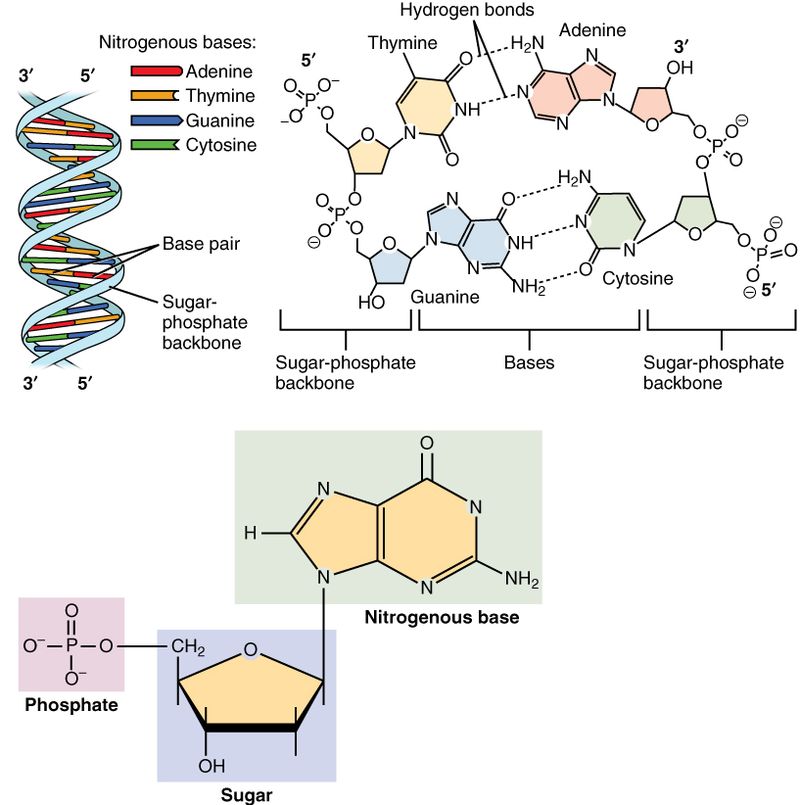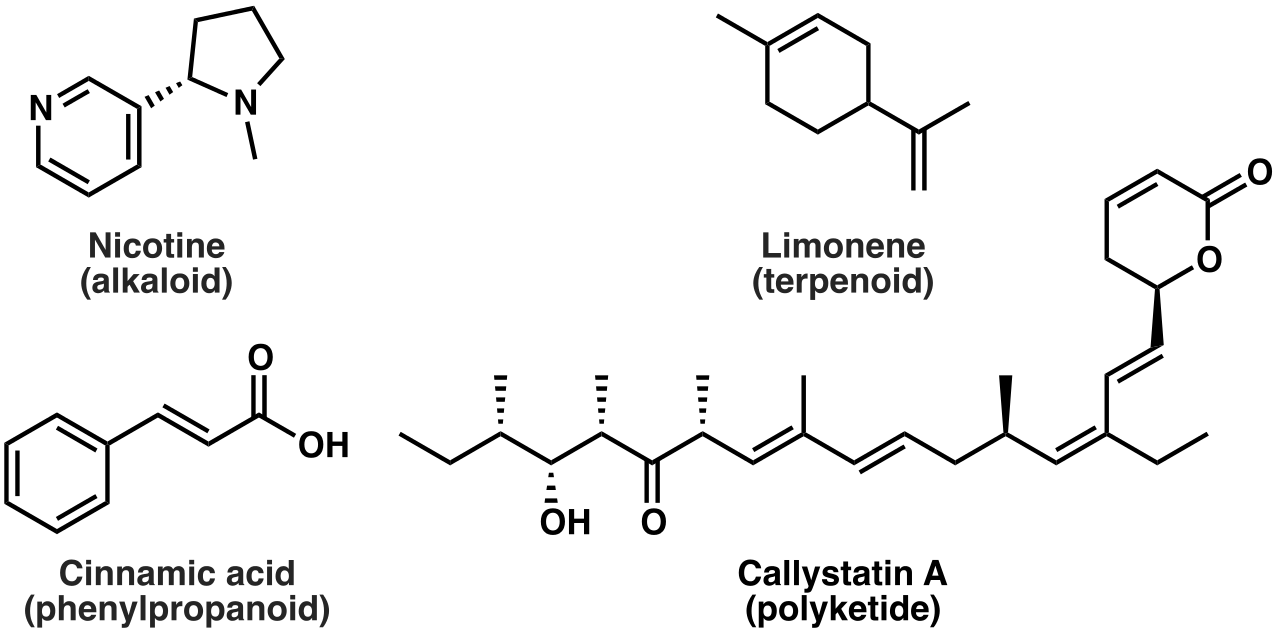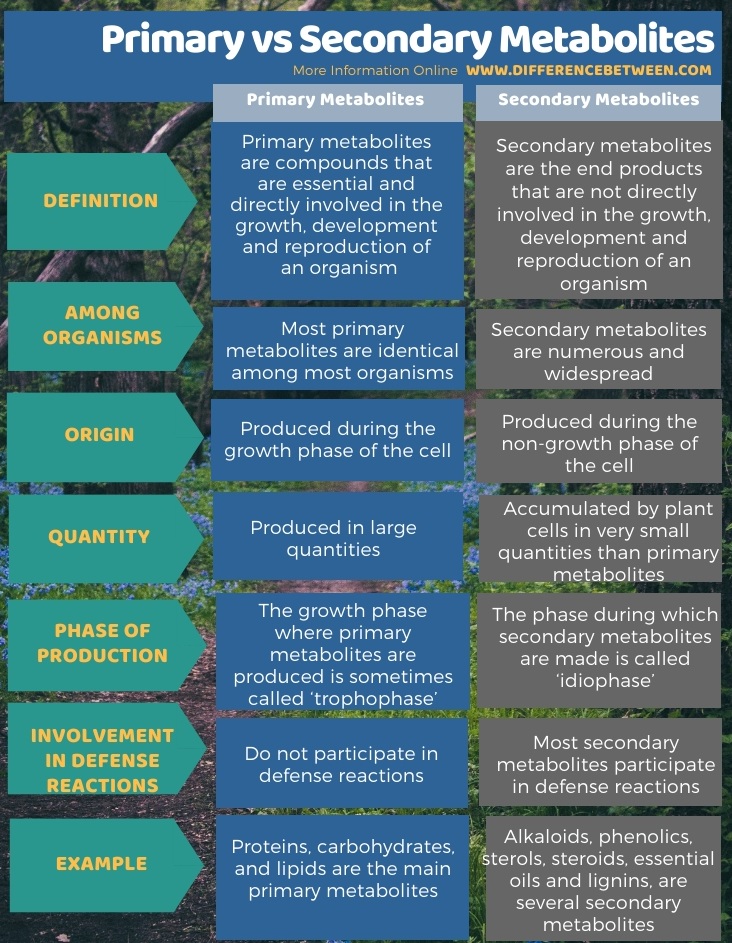The key difference between primary and secondary metabolites is that primary metabolites are the end products of metabolism that directly participate in normal growth, development and reproduction of an organism while secondary metabolites are the metabolites that do not directly participate in normal growth, development and reproduction of an organism.
Metabolites participate in the growth of organisms through the process of metabolism. Metabolism is the sum of all the biochemical reactions occurring in an organism. There are two major categories of metabolites depending on the origin and function. They are primary metabolites and secondary metabolites.
CONTENTS
1. Overview and Key Difference
2. What are Primary Metabolites
3. What are Secondary Metabolites
4. Similarities Between Primary and Secondary Metabolites
5. Side by Side Comparison – Primary vs Secondary Metabolites in Tabular Form
6. Summary
Primary metabolites are the end products of metabolism directly involved in growth, development and reproduction of an organism. Thus, they are essential for the organism. The cells produce primary metabolites continuously during its growth phase. These primary metabolites participate in primary metabolic processes such as respiration and photosynthesis.

Figure 01: Primary Metabolites – Nucleotides
Generally, primary metabolites are identical in most organisms. Examples of primary metabolites common in most organisms are sugars, amino acids, and tricarboxylic acids, which work as universal building blocks, and energy sources. In addition to the above compounds, proteins, nucleic acids, and polysaccharides are also considered as primary metabolites.
Secondary metabolites are the compounds that do not directly involve in growth, development and reproduction of an organism. But they are important for several additional functions such as protection, competition, and species interactions. They originate from the primary metabolic pathways as byproducts. However, unlike primary metabolites, they are not essential to sustain the life of cells.

Figure 02: Secondary Metabolites
Moreover, these compounds do not have continuous production. Very often, secondary metabolites are produced during the non-growth phase of cells. In fact, secondary metabolites are the end products of primary metabolites such as alkaloids, phenolics, steroids, essential oils, lignins, resins, and tannins, etc.
- Primary and secondary metabolites are the two main categories of metabolites present in living organisms.
- They are small organic compounds that act as signalling molecules, catalysts, stimulators or inhibitors of reactions.
Primary metabolites are the metabolites that are essential for growth, development and reproduction. In contrast, secondary metabolites are the metabolites that do not directly involve in growth, development and reproduction. Thus, this is the key difference between primary and secondary metabolites. Generally, primary metabolites are identical among most organisms, whereas secondary metabolites are numerous and widespread, unlike the primary metabolites. Moreover, secondary metabolites are the end products of primary metabolites.
Primary metabolites originate during the growth phase of the cell while secondary metabolites originate during the non-growth phase of the cell. Another difference between primary and secondary metabolites is that most secondary metabolites participate in defence reactions, unlike primary metabolites. Proteins, carbohydrates, and lipids are the main primary metabolites, while alkaloids, phenolics, sterols, steroids, essential oils and lignins are several examples of secondary metabolites.

Summary – Primary vs Secondary Metabolites
Primary and secondary metabolites are two types of metabolites found in living organisms. Primary metabolites are essential for the growth, development and reproduction of an organism while secondary metabolites are not essential for the growth, development and reproduction. But they often participate in defence reactions. Thus, this is the key difference between primary and secondary metabolites.
Moreover, primary metabolites are produced in higher amounts while secondary metabolites are produced in small quantities. Furthermore, primary metabolites originate during the growth phase of the cells while secondary metabolites originate during the stationary or non-growth phase of the cells. Primary metabolites are identical among most organisms while secondary metabolites are different and widespread among the organisms. This summarizes the difference between primary and secondary metabolites.
Reference:
1.“Primary Metabolite.” Primary Metabolite – an Overview | ScienceDirect Topics, Available here.
2. “Secondary Metabolites: Meaning, Role and Types.” Biology Discussion, 17 Aug. 2016, Available here.
Image Courtesy:
1. “0322 DNA Nucleotides” By OpenStax – (CC BY 4.0) via Commons Wikimedia
2. “Secondary metabolite class examples” By Boghog – Own work (Public Domain) via Commons Wikimedia
ncG1vNJzZmivp6x7pbXFn5yrnZ6YsqOx07CcnqZemLyue8OinZ%2Bdopq7pLGMm5ytr5Wau2680aKkmqqpYq6vsIyvqmarlZi8r7DAq7BmpZWprqO7y6Krnqtf